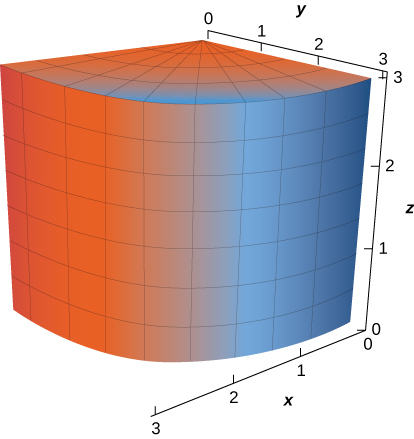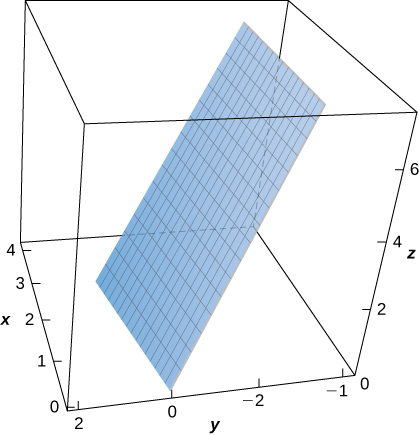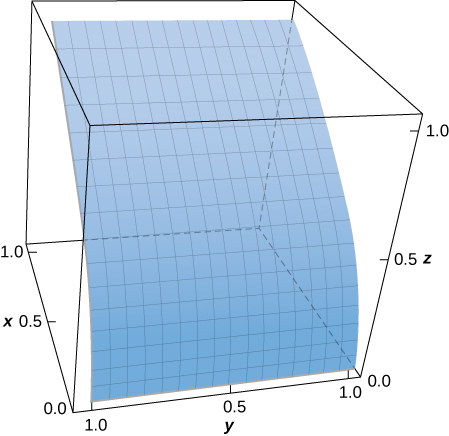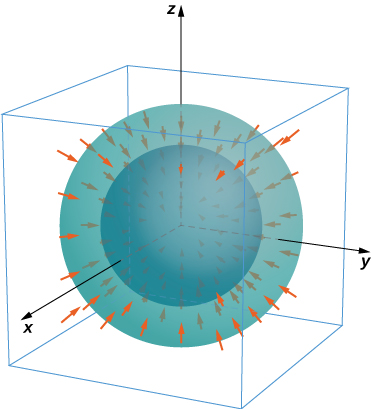9.6E: Exercises
- Page ID
- 26277
Exercise \(\PageIndex{1}\): True or false.
For the following exercises, determine whether the statements are true or false.
1. If surface S is given by \(\{(x,y,z) : \, 0 \leq x \leq 1, \, 0 \leq y \leq 1, \, z = 10 \}\), then \[\iint_S f(x,y,z) \, dS = \int_0^1 \int_0^1 f (x,y,10) \, dx dy.\]
- Answer
-
True
2. If surface S is given by \(\{(x,y,z) : \, 0 \leq x \leq 1, \, 0 \leq y \leq 1, \, z = x \}\), then \[\iint_S f(x,y,z) \, dS = \int_0^1 \int_0^1 f (x,y,x) \, dx dy.\]
3. Surface \(r = \langle v \, \cos u, \, v \, \sin u, \, v^2 \rangle, \, for \, 0 \leq u \leq \pi, \, 0 \leq v \leq 2\) is the same surface \(r = \langle \sqrt{v} \, \cos 2u, \, \sqrt{v} \, \sin 2u, \, v \rangle, \, for \, 0 \leq u \leq \dfrac{\pi}{2}, \, 0 \leq v \leq 4\).
- Answer
-
True
Exercise \(\PageIndex{2}\)
Given the standard parameterization of a sphere, normal vectors \(t_u \times t_v\) are outward normal vectors. For the following exercises, find parametric descriptions for the following surfaces.
1. Plane \(3x - 2y + z = 2\)
- Answer
-
\(r(u,v) = \langle u, \, v, \, 2 - 3u + 2v \rangle \) for \(-\infty \leq u < \infty\) and \( - \infty \leq v < \infty\).
2. Paraboloid \(z = x^2 + y^2\), for \(0 \leq z \leq 9\).
3. Plane \(2x - 4y + 3z = 16\)
- Answer
-
\(r(u,v) = \langle u, \, v, \, \dfrac{1}{3} (16 - 2u + 4v) \rangle \) for \(|u| < \infty\) and \(|v| < \infty\).
4. The frustum of cone \(z^2 = x^2 + y^2\), for \(2 \leq z \leq 8\)
5. The portion of cylinder \(x^2 + y^2 = 9\) in the first octant, for \(0 \leq z \leq 3\)

- Answer
-
\(r(u,v) = \langle 3 \, \cos u, \, 3 \, \sin u, \, v \rangle \) for \(0 \leq u \leq \dfrac{\pi}{2}, \, 0 \leq v \leq 3\)
6. A cone with base radius r and height h, where r and h are positive constants
- Answer
-
TBA
Exercise \(\PageIndex{3}\): Surface Area
For the following exercises, use a computer algebra system to approximate the area of the following surfaces using a parametric description of the surface.
1. [T] Half cylinder \(\{ (r, \theta, z) : \, r = 4, \, 0 \leq \theta \leq \pi, \, 0 \leq z \leq 7 \}\)
- Answer
-
\(A = 87.9646\)
2. [T] Plane \(z = 10 - z - y\) above square \(|x| \leq 2, \, |y| \leq 2\)
Exercise \(\PageIndex{4}\)
For the following exercises, let S be the hemisphere \(x^2 + y^2 + z^2 = 4\), with \(z \geq 0\), and evaluate each surface integral, in the counterclockwise direction.
1. \[\iint_S z\, dS\]
- Answer
-
\[\iint_S z \, dS = 8\pi\]
2. \[\iint_S (x - 2y) \, dS\]
3. \[\iint_S (x^2 + y^2) \, dS\]
- Answer
-
\[\iint_S z \, dS = 8\pi\]
Exercise \(\PageIndex{5}\)
For the following exercises, evaluate \[\int \int_S \vecs{F} \cdot \vecs{N} \, ds\] for vector field \(\vecs{F}\), where \(\vecs{N}\) is an outward normal vector to surface S.
1. \(\vecs{F}(x,y,z) = x \, \hat{ \mathbf i} + 2y\, \hat{ \mathbf j} + 3z\, \hat{ \mathbf k} \), and S is that part of plane \(15x - 12y + 3z = 6\) that lies above unit square \(0 \leq x \leq 1, \, 0 \leq y \leq 1\).
2. \(\vecs{F}(x,y) = x\, \hat{ \mathbf i} + y\, \hat{ \mathbf j} \), and S is hemisphere \(z = \sqrt{1 - x^2 - y^2}\).
- Answer
-
\[\iint_S F \cdot N \, dS = \dfrac{4\pi}{3}\]
3. \(F(x,y,z) = x^2 \, \hat{ \mathbf i} + y^2 \, \hat{ \mathbf j} + z^2 \, \hat{ \mathbf k} \), and S is the portion of plane \(z = y + 1\) that lies inside cylinder \(x^2 + y^2 = 1\).

Exercise \(\PageIndex{6}\)
For the following exercises, approximate the mass of the homogeneous lamina that has the shape of given surface S. Round to four decimal places.
1. [T] S is surface \(z = 4 - x - 2y\), with \(z \geq 0, \, x \geq 0, \, y \geq 0; \xi=x.\)
- Answer
-
\(m \approx 13.0639\)
2. [T] S is surface \(z = x^2 + y^2\), with \(z \leq 1; \, \xi = z\).
3. [T] S is surface \(x^2 + y^2 + x^2 = 5\), with \(z \geq 1; \, \xi = \theta^2\).
- Answer
-
\(m \approx 228.5313\)
Exercise \(\PageIndex{6}\)
1. Evaluate \[\iint_S (y^2 z\, \hat{ \mathbf i} + y^3\, \hat{ \mathbf j}+ xz\, \hat{ \mathbf k}) \cdot dS,\] where S is the surface of cube \(-1 \leq x \leq 1, \, -1 \leq y \leq 1\), and \(0 \leq z \leq 2\) in a counterclockwise direction.
2. Evaluate surface integral \[\iint_S gdS,\] where \(g(x,y,z) = xz + 2x^2 - 3xy\) and S is the portion of plane \(2x - 3y + z = 6\) that lies over unit square R: \(0 \leq x \leq 1, \, 0 \leq y \leq 1\).
- Answer
-
\[\iint_S gdS = 3 \sqrt{4}\]
3. Evaluate \[\iint_S (x + y + z)dS,\] where S is the surface defined parametrically by \(R(u,v) = (2u + v)\, \hat{ \mathbf i} + (u - 2v)\, \hat{ \mathbf j} + (u + 3v)\, \hat{ \mathbf k}\) for \(0 \leq u \leq 1\), and \(0 \leq v \leq 2\).

- Answer
-
TBA
Exercise \(\PageIndex{7}\)
1. [T] Evaluate \[\iint_S (x - y^2 + z)dS,\] where S is the surface defined parametrically by \(R(u,v) = u^2\, \hat{ \mathbf i} + v\, \hat{ \mathbf j} + u\, \hat{ \mathbf k}\) for \(0 \leq u \leq 1, \, 0 \leq v \leq 1\).

- Answer
-
\[\iint_S (x^2 + y - z) \, dS \approx 0.9617\]
2. [T] Evaluate where S is the surface defined by \(R(u,v) = u \, \hat{ \mathbf i} - u^2 \, \hat{ \mathbf j}+ v\, \hat{ \mathbf k}, \, 0 \leq u \leq 2, \, 0 \leq v \leq 1\) for \(0 \leq u \leq 1, \, 0 \leq v \leq 2\).
3. Evaluate \[ \iint_S (x^2 + y^2) \, dS,\] where S is the surface bounded above hemisphere \(z = \sqrt{1 - x^2 - y^2}\), and below by plane \(z = 0\).
- Answer
-
\[\iint_S (x^2 + y^2) \, dS = \dfrac{4\pi}{3}\]
4. Evaluate \[ \iint_S (x^2 + y^2 + z^2) \, dS,\] where S is the portion of plane that lies inside cylinder \(x^2 + y^2 = 1\).
5. [T] Evaluate \[\iint_S x^2 z dS,\] where S is the portion of cone \(z^2 = x^2 + y^2\) that lies between planes \(z = 1\) and \(z = 4\).

- Answer
-
\[\iint_S x^2 zdS = \dfrac{1023\sqrt{2\pi}}{5}\]
6. [T] Evaluate \[\iint_S (xz/y) \, dS,\] where S is the portion of cylinder \(x = y^2\) that lies in the first octant between planes \(z = 0, \, z = 5\), and \(y = 4\).

7. [T] Evaluate \[\iint_S (z + y) \, dS,\] where S is the part of the graph of \( z = \sqrt{1 - x^2}\) in the first octant between the xz-plane and plane \(y = 3\).

- Answer
-
\[\iint_S (z + y) \, dS \approx 10.1\]
Exercise \(\PageIndex{8}\)
1. Evaluate \[\iint_S xyz\, dS\] if S is the part of plane \(z = x + y\) that lies over the triangular region in the xy-plane with vertices (0, 0, 0), (1, 0, 0), and (0, 2, 0).
2. Find the mass of a lamina of density \(\xi (x,y,z) = z\) in the shape of hemisphere \(z = (a^2 - x^2 - y^2)^{1/2}\).
- Answer
-
\(m = \pi a^3\)
3. Compute \[\int \int_S F \cdot N \, dS,\] where \(F(x,y,z) = x \, \hat{ \mathbf i} - 5y \hat{j]+ 4z\, \hat{ \mathbf k}\) and \(\vecs{N}\) is an outward normal vector S, where S is the union of two squares \(S_1\) : \(x = 0, \, 0 \leq y \leq 1, \, 0 \leq z \leq 1\) and \(S_2 \, : \, x = 0, \, 0 \leq x \leq 1, \, 0 \leq y \leq 1\).

4. Compute \[\int \int_S F \cdot N \, dS,\] where \(F(x,y,z) = xy \, \hat{ \mathbf i} + z\, \hat{ \mathbf j} + (x + y) \, \hat{ \mathbf k}\) and \(\vecs{N}\) is an outward normal vector S, where S is the triangular region cut off from plane \(x + y + z = 1\) by the positive coordinate axes.
- Answer
-
\[\iint_S F \cdot N \, dS = \dfrac{13}{24}\]
Exercise \(\PageIndex{9}\)
Compute \[\int \int_S F \cdot N \, dS,\] where \(F(x,y,z) = 2yz\, \hat{ \mathbf i}+ (tan^{-1}xz)\, \hat{ \mathbf j} + e^{xy}\, \hat{ \mathbf k}\) and \(\vecs{N}\) is an outward normal vector S, where S is the surface of sphere \(x^2 + y^2 + z^2 = 1\).
Compute \[\int \int_S F \cdot N \, dS,\] where \(F(x,y,z) = xyz\, \hat{ \mathbf i}+ xyz\, \hat{ \mathbf j} + xyz\, \hat{ \mathbf k}\) and \(\vecs{N}\) is an outward normal vector S, where S is the surface of the five faces of the unit cube \(0 \leq x \leq 1, \, 0 \leq y \leq 1, \, 0 \leq z \leq 1\) missing \(z = 0\).
[Hide Solution]
\[\iint_S F \cdot N \, dS = \dfrac{3}{4}\]
For the following exercises, express the surface integral as an iterated double integral by using a projection on S on the yz-plane.
\[\iint_S xy^2 z^3 \, dS;\] S is the first-octant portion of plane \(2x + 3y + 4z = 12\).
\[\iint_S (x^2 - 2y + z \, dS;\] S is the portion of the graph of \(4x + y = 8\) bounded by the coordinate planes and plane \(z = 6\).
[Hide Solution]
\[\int_0^8 \int_0^6 \left( 4 - 3y + \dfrac{1}{16} y^2 + z \right) \left(\dfrac{1}{4} \sqrt{17} \right) \, dz dy\]
Exercise \(\PageIndex{10}\)
For the following exercises, express the surface integral as an iterated double integral by using a projection on S on the xz-plane
\[\iint_S xy^2z^3 \, dS;\] S is the first-octant portion of plane \(2x + 3y + 4z = 12\).
\[\iint_S (x^2 - 2y + z) \, dS;\] is the portion of the graph of \(4x + y = 8\) bounded by the coordinate planes and plane \(z = 6\).
[Hide Solution]
\[\int_0^2 \int_0^6 [x^2 - 2 (8 - 4x) + z] \sqrt{17} \, dz dx\]
- Answer
-
Add texts here. Do not delete this text first.
Exercise \(\PageIndex{11}\)
Evaluate surface integral \[\iint_S yz \, dS,\] where S is the first-octant part of plane \(x + y + z = \lambda\), where \(\lambda\) is a positive constant.
Evaluate surface integral \[\iint_S (x^2 z + y^2 z) \, dS,\] where S is hemisphere \(x^2 + y^2 + z^2 = a^2, \, z \geq 0.\)
[Hide Solution]
\[\iint_S (x^2 z + y^2 z) \, dS = \dfrac{\pi a^5}{2}\]
Evaluate surface integral \[\iint_S zdA,\] where S is surface \(z = \sqrt{x^2 + y^2}, \, 0 \leq z \leq 2\).
Evaluate surface integral \[\iint_S x^2 yz \, dS,\] where S is the part of plane \(z = 1 + 2x + 3y\) that lies above rectangle \(0 \leq x \leq 3\) and \(0 \leq y \leq 2\).
[Hide Solution]
\[\iint_S x^2 yz \, dS = 171 \sqrt{14}\]
Evaluate surface integral \[\iint_S yz \, dS,\] where S is plane \(x + y + z = 1\) that lies in the first octant.
Evaluate surface integral \[\iint_S yz \, dS,\] where S is the part of plane \(z = y + 3\) that lies inside cylinder \(x^2 + y^2 = 1\).
[Hide Solution]
\[\iint_S yz \, dS = \dfrac{\sqrt{2}\pi}{4}\]
Exercise \(\PageIndex{12}\)
For the following exercises, use geometric reasoning to evaluate the given surface integrals.
\[\iint_S \sqrt{x^2 + y^2 + z^2} \, dS,\] where S is surface \(x^2 + y^2 + z^2 = 4, \, z \geq 0\)
\[\iint_S (xi + yj) \cdot dS,\] where S is surface \(x^2 + y^2 = 4, \, 1 \leq z \leq 3\), oriented with unit normal vectors pointing outward
[Hide Solution]
\[\iint_S (xi + yj) \cdot dS = 16 \pi\]
\[\iint_S (zk) \cdot dS,\] where S is disc \(x^2 + y^2 \leq 9\) on plane \(z = 4\) oriented with unit normal vectors pointing upward
Exercise \(\PageIndex{13}\)
A lamina has the shape of a portion of sphere \(x^2 + y^2 + z^2 = a^2\) that lies within cone \(z = \sqrt{x^2 + y^2}\). Let S be the spherical shell centered at the origin with radius a, and let C be the right circular cone with a vertex at the origin and an axis of symmetry that coincides with the z-axis. Determine the mass of the lamina if \(\delta(x,y,z) = x^2 y^2 z\).

[Hide Solution]
\(m = \dfrac{\pi a^7}{192}\)
A lamina has the shape of a portion of sphere \(x^2 + y^2 + z^2 = a^2\) that lies within cone \(z = \sqrt{x^2 + y^2}\). Let S be the spherical shell centered at the origin with radius a, and let C be the right circular cone with a vertex at the origin and an axis of symmetry that coincides with the z-axis. Suppose the vertex angle of the cone is \(\phi_0\), with \(0 \leq \phi_0 < \dfrac{\pi}{2}\). Determine the mass of that portion of the shape enclosed in the intersection of S and C. Assume \(\delta(x,y,z) = x^2y^2z.\)

A paper cup has the shape of an inverted right circular cone of height 6 in. and radius of top 3 in. If the cup is full of water weighing \(62.5 \, lb/ft^3\), find the total force exerted by the water on the inside surface of the cup.
[Hide Solution]
\(F \approx 4.57 \, lb\)
Exercise \(\PageIndex{14}\)
For the following exercises, the heat flow vector field for conducting objects \(\vecs{F} = - k\nabla T\), where \(T(x,y,z)\) is the temperature in the object and \(k > 0\) is a constant that depends on the material. Find the outward flux of \(\vecs{F}\) across the following surfaces S for the given temperature distributions and assume \(k = 1\).
\(T(x,y,z) = 100 e^{-x-y}\); S consists of the faces of cube \(|x| \leq 1, \, |y| \leq 1, \, |z| \leq 1\).
\(T(x,y,z) = - \ln (x^2 + y^2 + z^2)\); S is sphere \(x^2 + y^2 + z^2 = a^2\).
[Hide Solution]
\(8\pi a\)
Exercise \(\PageIndex{15}\)
For the following exercises, consider the radial fields \(F = \dfrac{\langle x,y,z \rangle}{(x^2+y^2+z^2)^{\dfrac{p}{2}}} = \dfrac{r}{|r|^p}\), where p is a real number. Let S consist of spheres A and B centered at the origin with radii \(0 < a < b\). The total outward flux across S consists of the outward flux across the outer sphere B less the flux into S across inner sphere A.

Find the total flux across S with \(p = 0\).
Show that for \(p = 3\) the flux across S is independent of a and b.
- Answer
-
The net flux is zero.


